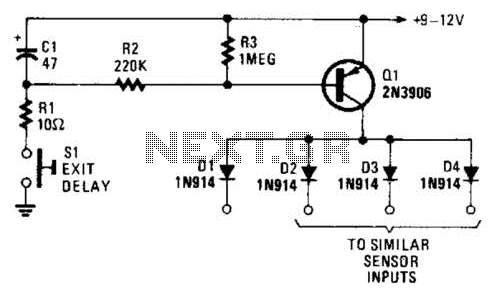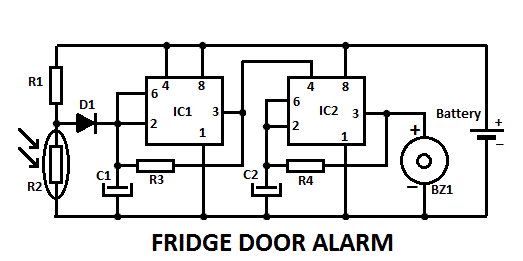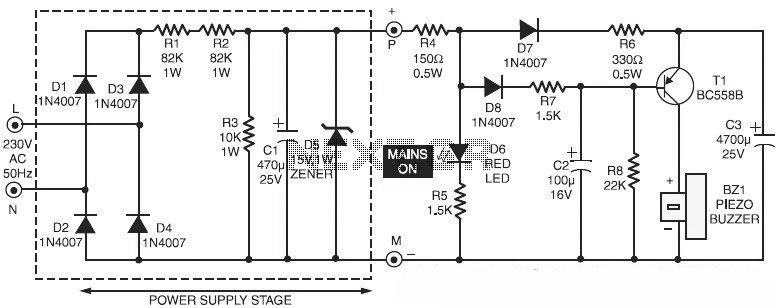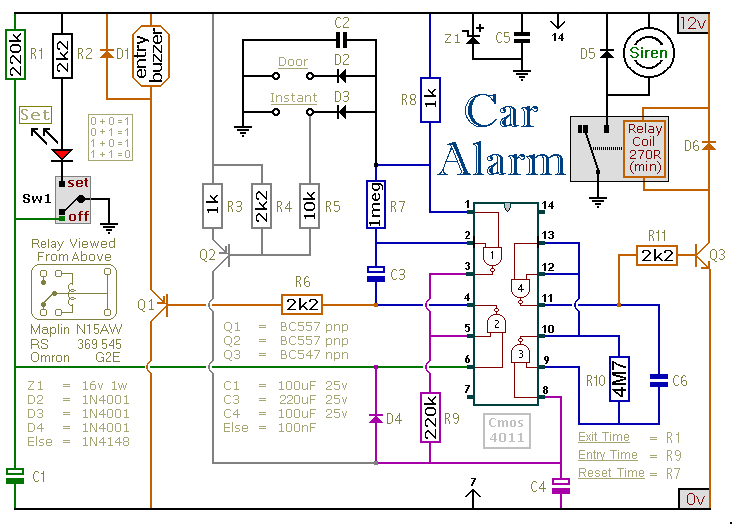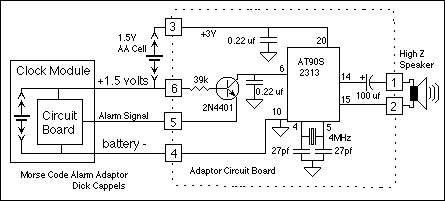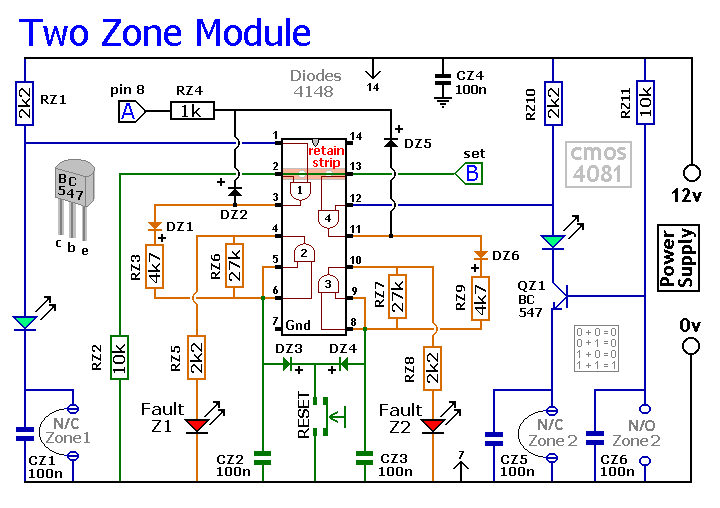
Shed/Garage Alarm
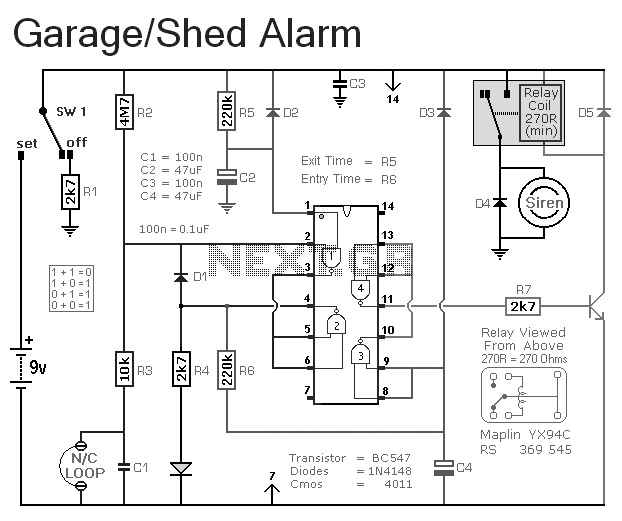
This is a simple single-zone burglar alarm circuit. Its features include automatic exit and entry delays. It is designed to be used with the usual types of normally-closed input devices such as magnetic reed contacts, micro switches, foil tape, and passive infrared sensors (PIRs). It has an extremely low standby current, making it ideal for battery-powered operation. A 9-volt battery is used in the diagram; however, the circuit can operate within a voltage range of 5 to 15 volts. It is essential to select a relay and siren that are suitable for the chosen voltage. The operation is straightforward: to set the alarm, move switch SW1 to the "set" position, providing approximately 10 to 15 seconds to exit the building. Upon returning and opening the door, the green LED will illuminate, indicating that there is a further 10 to 15 seconds to move SW1 to the "off" position. If this action is not taken, the relay will activate, and the siren will sound. The siren can be deactivated at any time by switching SW1 to the "off" position. Due to manufacturing tolerances, the exact duration of the delays will depend on the specific components used in the circuit. However, by adjusting the values of resistors R5 and R6, the exit and entry times can be modified to meet specific requirements; increasing the resistor values will extend the timing, while decreasing them will shorten it.
This burglar alarm circuit is designed for simplicity and effectiveness, providing an essential security feature for residential or small commercial applications. The circuit employs a standard configuration that includes a microcontroller or timer IC for managing the timing functions, alongside a relay to control the siren. The use of normally-closed input devices ensures that the circuit remains in a stable state until an intrusion is detected, at which point the circuit is disrupted, triggering the alarm.
The design is optimized for low power consumption, making it suitable for battery operation, which is critical in ensuring continuous monitoring without the need for frequent battery changes. The choice of input devices allows for flexibility in installation, accommodating various entry points such as doors and windows. The adjustable timing feature through R5 and R6 not only personalizes the alarm system but also enhances usability, allowing users to configure the system according to their daily routines.
The inclusion of an LED indicator provides visual feedback, enhancing user experience by confirming the status of the alarm system. The circuit layout should be carefully designed to minimize noise and interference, ensuring reliable operation in diverse environments. Proper placement of components and routing of connections will also contribute to the overall performance and longevity of the burglar alarm system.This is a simple single-zone burglar alarm circuit. Its features include automatic Exit and Entry delays. It`s designed to be used with the usual types of normally-closed input devices such as - magnetic-reed contacts - micro switches - foil tape - and PIRs. It has an extremely small standby current - making it ideal for battery-powered operation. I`ve used a 9-volt battery in the diagram - but the circuit will work at anything from 5 to 15-volts. Just choose a relay and Siren suitable for the voltage you want to use. It`s easy to use. To set the alarm move SW1 to the "set" position. You now have about 10 to 15 seconds to leave the building. When you return and open the door - the green LED will light. You then have about 10 to 15 seconds to move SW1 to the "off" position. If you fail to do so - the relay will energize and the Siren will sound. Of course - you can turn the Siren off at any time by moving SW1 to the "off" position. Because of manufacturing tolerances - the precise length of any delay depends on the characteristics of the actual components you`ve used in your circuit.
But by altering the values of R5 & R6 you can adjust the Exit and Entry times to suit your requirements. Increasing the values increases the time - and vice-versa. 🔗 External reference
This burglar alarm circuit is designed for simplicity and effectiveness, providing an essential security feature for residential or small commercial applications. The circuit employs a standard configuration that includes a microcontroller or timer IC for managing the timing functions, alongside a relay to control the siren. The use of normally-closed input devices ensures that the circuit remains in a stable state until an intrusion is detected, at which point the circuit is disrupted, triggering the alarm.
The design is optimized for low power consumption, making it suitable for battery operation, which is critical in ensuring continuous monitoring without the need for frequent battery changes. The choice of input devices allows for flexibility in installation, accommodating various entry points such as doors and windows. The adjustable timing feature through R5 and R6 not only personalizes the alarm system but also enhances usability, allowing users to configure the system according to their daily routines.
The inclusion of an LED indicator provides visual feedback, enhancing user experience by confirming the status of the alarm system. The circuit layout should be carefully designed to minimize noise and interference, ensuring reliable operation in diverse environments. Proper placement of components and routing of connections will also contribute to the overall performance and longevity of the burglar alarm system.This is a simple single-zone burglar alarm circuit. Its features include automatic Exit and Entry delays. It`s designed to be used with the usual types of normally-closed input devices such as - magnetic-reed contacts - micro switches - foil tape - and PIRs. It has an extremely small standby current - making it ideal for battery-powered operation. I`ve used a 9-volt battery in the diagram - but the circuit will work at anything from 5 to 15-volts. Just choose a relay and Siren suitable for the voltage you want to use. It`s easy to use. To set the alarm move SW1 to the "set" position. You now have about 10 to 15 seconds to leave the building. When you return and open the door - the green LED will light. You then have about 10 to 15 seconds to move SW1 to the "off" position. If you fail to do so - the relay will energize and the Siren will sound. Of course - you can turn the Siren off at any time by moving SW1 to the "off" position. Because of manufacturing tolerances - the precise length of any delay depends on the characteristics of the actual components you`ve used in your circuit.
But by altering the values of R5 & R6 you can adjust the Exit and Entry times to suit your requirements. Increasing the values increases the time - and vice-versa. 🔗 External reference
